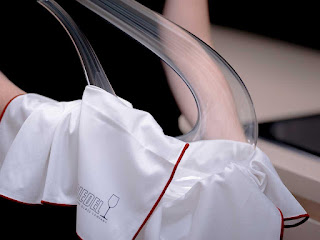The history of decanters goes back thousands of years and originally they were mostly made of bronze, silver, gold or earthenware.
The Romans originally introduced the use of glass as a material but after the fall of the Roman Empire glass became a scarce commodity, and it wasn’t until the Venetians re-introduced glass during the Renaissance that glass decanters made a comeback.
By the18th century decanters were used mainly to present the wine minus the sediment which built up in the original bottle as the wine aged. By transferring the wine into a clear vessel the sediment could then be discarded. Most decanters from that time were made of glass or lead crystal, and as the popularity of bottled wine increased, decanters became more and more in demand.
However, although their initial function was to present the wine minus the sediment, manufacturers began to realise that more sophisticated designs would make the crystal decanter a decorative item as well as a useful one.
The original crystal decanters were hand blown, hand cut and hand engraved, which made them a much sought after item in the homes of the affluent, and added to the prestige of the household. The fact that they showed off the colour and clarity of the wine made it an attractive and elegant item to have displayed on the dining room table. The British glass makers introduced the stopper in the 1730’s to limit exposure of the wine to the air.
The 18th century dining room became a clearly defined area within the home, and dining customs were established and became an important part of one’s social life. By 1770 vulgar bottles were no longer displayed in dining rooms, and the decanter enabled guests to serve themselves at the table.
The custom was to pass the decanter to your left around the table. The host always filled the glass of the guest to his right first however, so that he didn’t have to wait for the decanter to go all the way around the table. Where previously staff had been at hand in the dining room to pour the wine from bottles, this was no longer necessary and they were banished to the kitchen.
By the 19th century pottery had become a thriving industry and ceramic decanters started to be produced. They’re used as decanters for spirits as well as wines and ports and come in all shapes and designs.
Unfortunately the post war demise of the decanter seems to be mainly due to the faster pace of life, which to a certain extent has taken the elegance out of dining. It’s considered by many that wine from a bottle has not been allowed to breathe and so the full flavour is lost. The effect of air on the wine as it’s decanted has an enlivening effect and it’s believed by some that even cheap wine can benefit from being decanted.
Check out at Amazon the beautiful Riedel Amadeo decanter displayed at the introduction of this article. It is really an exquisit piece of art and so very popular.
The history of decanters is a fascinating one, and shows how the upper classes in the 18th century defined their status by the splendour and elegance of these beautiful objects.
Check out this Youtube video to see how nowadays hobbyists make wine decanters through glass blowing.

